Hiking and backpacking continue to be a passion of mine.
Being in nature and breathing in the pure air fills me with energy and gratitude for this lifetime. Discovering with such intimate closeness the trees, desert, plants, water, atmosphere, and the earth in all her magnificence is divine for me.
In parts 1 and 2 we have looked at how the practice of strengthening and stretching the shoulders, neck, and the spine all work well to support hiking and carrying the backpack. Now, let’s explore the importance of the arms, hips and legs.
Yoga Poses for Sustaining Us on Long Hikes
The arms are lifting and lowering the backpack repeatedly all day long. Every time you stop to rest, the backpack comes off and then back on again. This requires strength and flexibility in the wrists, arms, and shoulders. The legs and hips are carrying you forward, up and down mountain slopes. Many miles of walking will naturally affect the legs and they will stiffen if they are not tended to. With the constant walking the legs muscles strengthen, so stretching them daily helps prevent the muscles from becoming short.
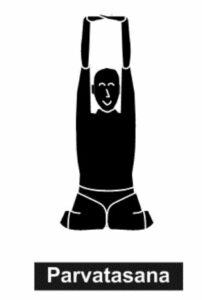
In this image of Parvatasana, the figure’s chosen seated pose is Virasana or Hero.
Parvatasana (seated mountain pose) is beneficial because it will stretch both the hips and arms. You can choose different seated poses to open the hips in various ways. (see image)
You can interlock the fingers and stretch the arms up, bringing a nice stretch to the fingers and wrists. Or you can press the palms together in prayer position, bringing strength into the arms.
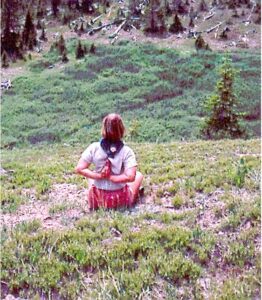
Doing prayer position behind the back will open the shoulders across the chest and stretch the triceps, deltoids, and infraspinatus muscles.
Gomukhasana (cow head) will also stretch both the hips and arms. In the image for Gomukhasana, the seated pose is Samkatasana, the “joining together” of the legs. (Also known as “shoelace pose” in Yin Yoga.) and
In Gomukhasana, the triceps and biceps get a good stretch while opening the shoulders. You can use a sock to help connect the hands behind the back, if needed. This will give a good massage into the shoulders while the position of the legs stretch the hips.
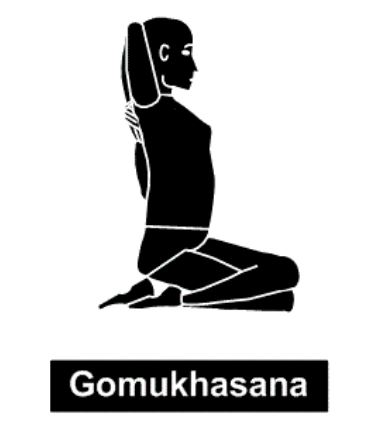
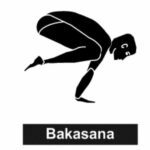 A good pose to strengthen the arms and wrists is Bakasana (crow or crane
A good pose to strengthen the arms and wrists is Bakasana (crow or crane
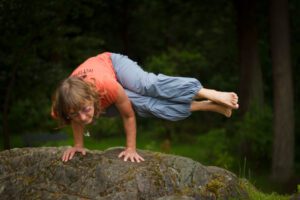
Parsva Bakasana, the side crow.
pose). Any one of its variations or other hand balance asanas will be good.
Chakrasana (wheel pose) is also excellent to stretch and strengthen the arms and wrists, and was discussed in Part 2.
All the above asanas are adaptable to do in the tent when the weather offers awkward conditions like snow, rain, mud, and an abundance of mosquitoes. Adding in a few side stretches of the neck and gentle neck rolls will help to release tension in the neck and shoulders.
Traversing up steep inclines or “bushwacking” (hiking cross-country without a trail) can result in tight calves, hamstrings, and quadriceps. These large muscles tend to hold onto their stiffness, so they need a great deal of attention to avoid tightening. Virasana, as shown above, and Vajrasana (thunderbolt- same as Virasana but sitting on the heels instead of between them) will help to stretch out the quadriceps. Samkatasana will also stretch glutes in the buttocks.
Two of the most beneficial postures for hamstrings and calf muscles are Meruasana (Mount Meru pose – aka Adho Mukha Svanasana or downward facing dog) and Avasvatikasana (squat). (Special note here… Mt Meru is a sacred mountain in the Himalayas, and this is the classical name for downward facing dog, because the pose looks like a mountain).
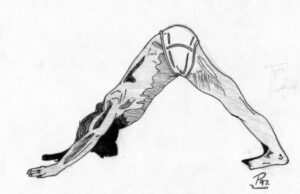
In Meruasana, you can see how the back of the legs are extended while the heels lower to the earth. “Walking” the feet in the pose can assist the stretching of the hamstrings, calves, ankles, and the Achilles tendon. Lengthening the Achilles tendon will help protect it when walking on uneven ground.
And look at the arms! They are engaging and strengthening while the backs of the legs are lengthening.
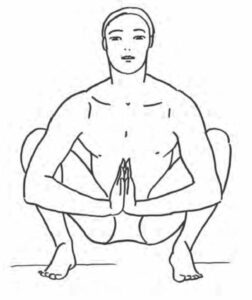 Avasvatikasana (squat, also known as Malasana) will be useful to keep the calves and Achilles tendon lengthened. It is also one of the most useful asanas for balance. When you live in the wilderness, the squat is essential for going to the bathroom, so it sure is nice to be good at it!
Avasvatikasana (squat, also known as Malasana) will be useful to keep the calves and Achilles tendon lengthened. It is also one of the most useful asanas for balance. When you live in the wilderness, the squat is essential for going to the bathroom, so it sure is nice to be good at it!
The adductors or groin muscles in the inner thigh areas tighten, especially from struggling against the force of the wind or carry the pack weight up hill. Depending on your level of ability Prasarita Padottanasana, (stretching legs widely in a standing forward bend) and Upavishta Konasana (stretching legs widely in a seated forward bend) will help to keep these groin muscles long.
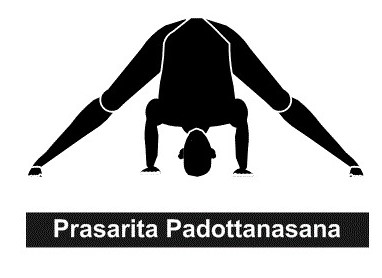
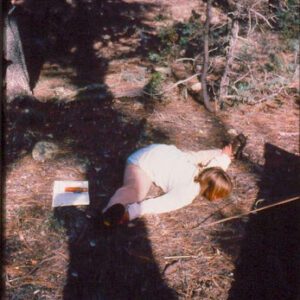
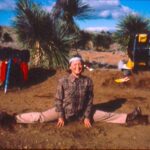
A more advanced pose, Samakonasana (center or middle splits pose) will also help to keep these long and flexible.
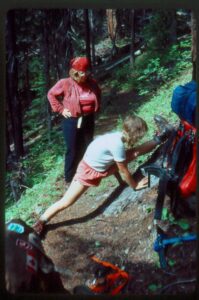
Another advanced asana, Hanumanasana (forward splits poses) is also good for stretching the hamstrings, hip flexors and groin muscles. Use the environment, such as the bank along the trail or a fallen log, to help get a good stretch.
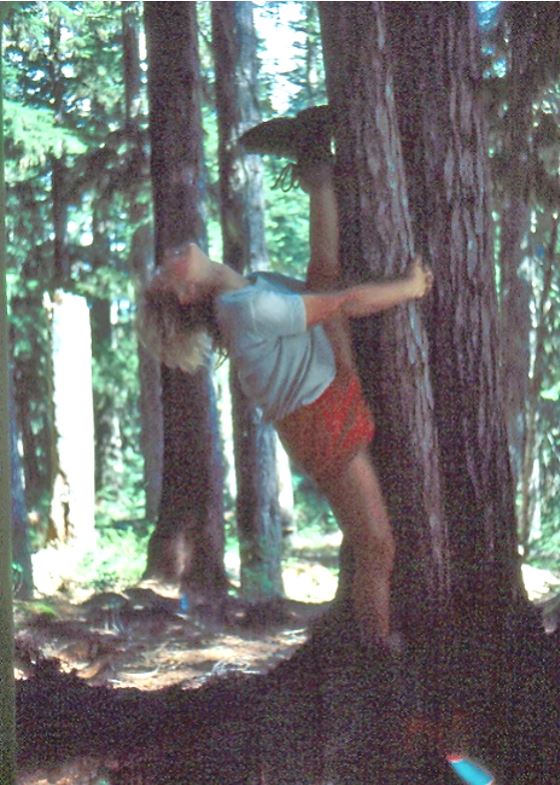
Paschimottanasana (head to knee) stretches the backs of the legs and hip joints, and if you do Janu sirsasana (single leg head to knee), putting the ankle on the thigh, you stretch the ankles too, as you will in Padmasana (lotus). The ankles stiffen with all the walking on trails and cross-country travel.
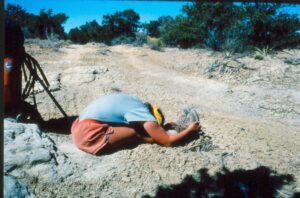
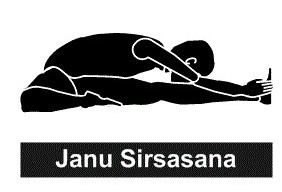
It may not seem like it, but regularly doing my asanas on the trail was a very challenging disciple. It was always much easier for me to do pranayama or meditate. But without the asana practice I would feel very muscle-bound in the arms, shoulders and legs. My body would stiffen, and it would become more and more difficult to move past the normal aches and pains that come with long-distance hiking. Which is why I was motivated to do this study of asanas on the trail. The study gave me purpose to do the asanas regardless of the conditions, and I really wanted to know what would help my body to feel good all along the journey. Finding purpose is a key to discipline, and I am grateful I kept up the practice!
To be continued….. Part 4 will be balance asanas, inversions and adapting poses for various weather conditions.
Photo credits: Avasvatikasana, IYTA/SOYA YTT Manual. Meruasana, Thor Polukoshko. Mugs’ asanas on trail, Jo Willems. Side crow, Galen Scorer. Yoga font for all digital graphics.
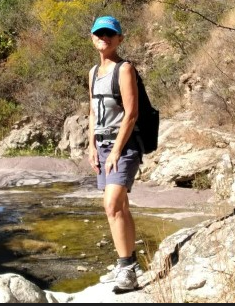
Marion Mugs McConnell is the co-founder of SOYA and the SOYA Yoga Teacher Training program. She is an avid backpacker, hiker, and yoga student. She is the author of Letters from the Yoga Masters: Teachings Revealed through Correspondence from Paramhansa Yogananda, Ramana Maharshi, Swami Sivananda, and Others, published by North Atlantic Books copyright © 2016 ISBN 978-1-62317-035-6.

Recent Comments